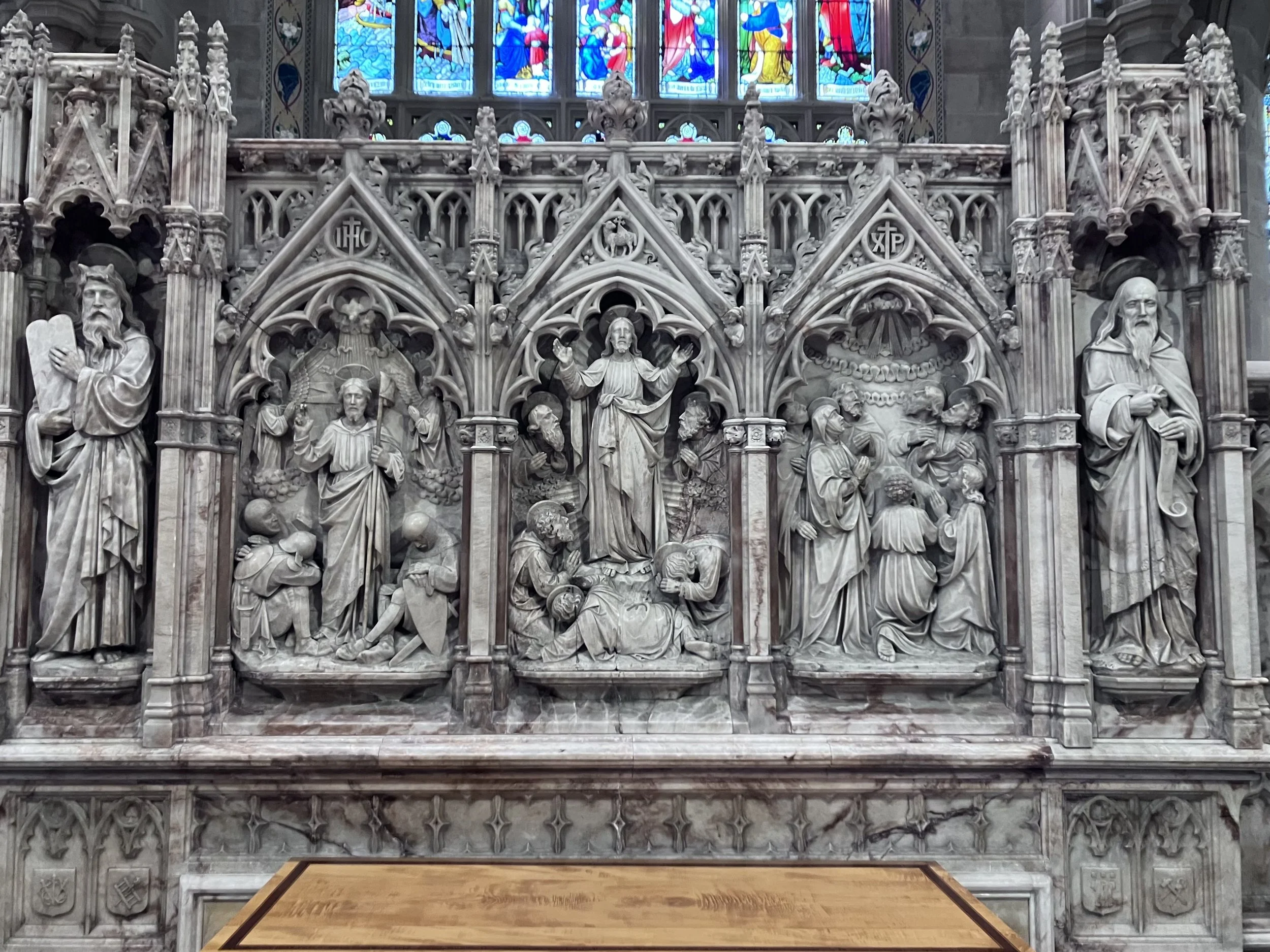How Jesus Shines
CATHEDRAL NEWSLETTER - 4 September 2025
Friends in Christ, I hope you have been helped by the series of lessons from the life of Jacob over recent weeks. I've had some great conversations arising from our time in Genesis.
In two Sunday's time, we return to Mark's Gospel, from chapter 9. The transfiguration of Christ, before Peter, James and John, will be the first of the episodes we consider. It was a glimpse of the glory that rightly belongs to Jesus.
Reredos, St Andrew’s Cathedral, Sydney, featuring (LTR) the resurrection, transfiguration and ascension of Jesus, bounded by Moses and Elijah.
Perhaps you have noted that the transfiguration features as the centre piece of the carved alabaster reredos (i.e. ornamental screen) behind the cathedral's holy table), between scenes of the resurrection and ascension of Jesus. Tourists to the Cathedral often want a good look.
As I was preparing for weeks ahead, I was taken by this extended quote, about how brightly Jesus shines, from Philip Schaff (1819 – 1893).
He was a Swiss-born, German-educated Protestant theologian and Church historian, who spent most of his adult life living and teaching in the United States.
No biographer, moralist, or artist can be satisfied with any attempt of his to set forth the beauty of holiness which shines from the face of Jesus of Nazareth. It is felt to be infinitely greater than any conception or representation of it by the mind, the tongue, or the pencil of man or angel. We might as well attempt to empty the waters of the boundless sea into a narrow well, or to portray the splendor of the risen sun and the starry heavens with ink. No picture of the Saviour, though drawn by the master hand of a Raphael or Dürer or Rubens; no epic, though conceived by the genius of a Dante or Milton or Klopstock,—can improve on the artless, narrative of the Gospels, whose only but all-powerful charm is truth. In this case, certainly, truth is stranger than fiction, and speaks best for itself without comment, explanation, or eulogy. Here, and here alone, the highest perfection of art falls short of the historical fact, and fancy finds no room for idealizing the real; for here we have the absolute ideal itself in living reality. It seems to me that this consideration alone should satisfy any reflecting mind that Christ’s character, though truly natural and human, rises far above the ordinary proportions of humanity, and can not be classified with the purest and greatest of our race...
Here is just the logical inconsistency, contradiction, and absurdity of those unbelievers who admit the extraordinary character of Christ’s person, and yet deny his extraordinary works. They admit a cause without a corresponding effect, and involve the person in conflict with his works, or the works with the person. You may as well expect the sun to send forth darkness as to expect ordinary works from such an extraordinary being. The person of Christ accounts for all the wonderful phenomena in his history, as a sufficient cause for the effect. Such a power over the soul as he possessed, and still exercises from day to day throughout Christendom,—why should it not extend also over the lesser sphere of the body? What was it for him, who is spiritually the Resurrection and the Life of the race, to call forth a corpse from the grave? Could such a heavenly life and heavenly death as his end in any other way than in absolute triumph over death, and in ascension to heaven, its proper origin and home?
The supernatural and miraculous in Christ, let it be borne in mind, was not a borrowed gift or an occasional manifestation, as we find it among the prophets and apostles, but an inherent power in constant silent or public exercise. An inward virtue dwelt in his person, and went forth from him, so that even the fringe of his garment was healing to the touch through the medium of faith which is the bond of union between him and the soul. He was the true Shekinah, and shone in all his glory, not before the multitude or the unbelieving Pharisees and scribes, but when he was alone with his Father, or walked in the dark night over the waves of the sea, calming the storm of nature and strengthening the faith of his timid disciples, or when he stood between Moses and Elijah before his favorite three on the mount of transfiguration.
Thus from every direction we arrive at the conclusion, that Christ, though truly natural and human, was at the same time truly supernatural and divine. The wonderful character of his person forces upon us the inevitable admission of the indwelling of the Divinity in him, as the only rational and satisfactory explanation of this mysterious fact; and this is the explanation which he gives himself.
– The Person of Christ: The Perfection of His Humanity Viewed as a Proof of His Divinity (first published 1866)
To chew it all over you might need to read through twice, but I think Schaff had a way with words!
Warmly in Christ,
Sandy Grant
Dean of Sydney
